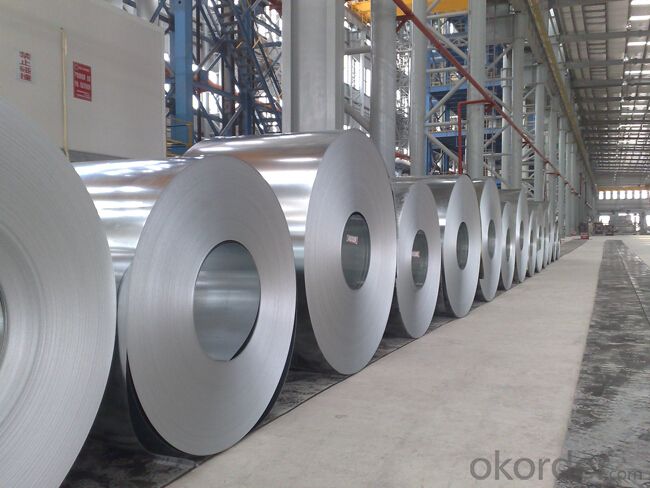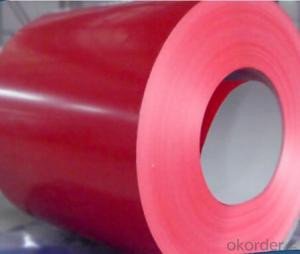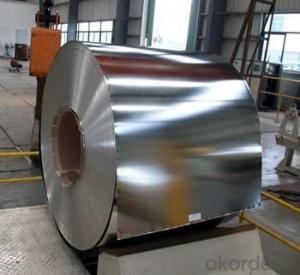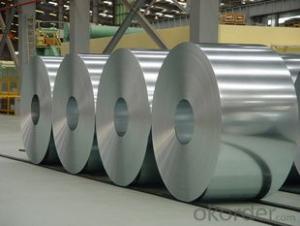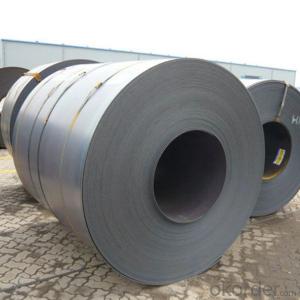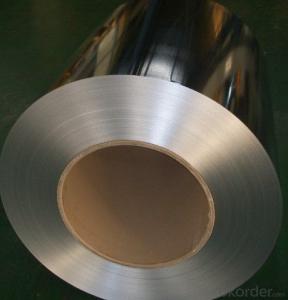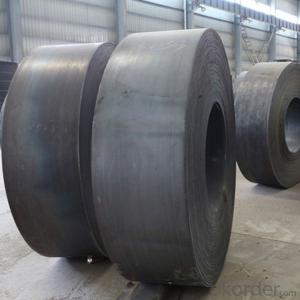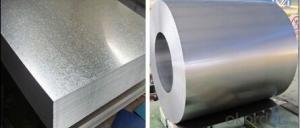Good Galvanized Steel Coil from China with Best Price
- Loading Port:
- Tianjin
- Payment Terms:
- TT OR LC
- Min Order Qty:
- 50 m.t.
- Supply Capability:
- 30000 m.t./month
OKorder Service Pledge
OKorder Financial Service
You Might Also Like
Specification
1. Hot-Dip Galvanized Steel Coil Description:
Hot-dip galvanized steel coil are available with a pure zinc coating through the hot-dip galvanizing process. It offers the economy, strength and formability of steel combined with the corrosion resistance of zinc. The hot-dip process is the process by which steel gets coated in layers of zinc to protect against rust. It is especially useful for countless outdoor and industrial application.
2.
Hot-Dip Galvanized Steel Coil Specification
Standard: AISI, ASTM, BS, DIN, GB, JIS
Grade: SPCC, SPCD, Q195, DX51D
Thickness: 0.15-5.0mm
Model Number: coil
Type: Steel Coil
Technique: Cold Rolled
Surface Treatment: Galvanized
Application: Container Plate
Special Use: High-strength Steel Plate
Width: 600-1250mm
Length: depends
commodity: hot dipped galvanized steel coil
technique: cold rolled
thickness: 0.15-5.0mm
width: 600-1500mm
surface treatment: galvanized
zinc coating: 50-275g/m2
coil weight: 3-7 tons
coil ID: 508/610mm
spangle: zero spangle, regular spangle, small spangle, big spangle
payment term: by L/C or T/T
3.
Main Features of the Hot-Dip Galvanized Steel Coil:
• Excellent process capability
• Smooth and flat surface
• Workability, durability
• Excellent heat resistance performance
• High strength
• Good formability
• Good visual effect
4.FAQ of Hot-Dip Galvanized Steel Coil
What’s the application of this product?
There are many applications for this product. For example, roofing, cladding, decking, tiles, sandwich walls, etc.
What’s the coating composition of Hot-Dip Galvanized Steel Coil?
The coating composition is 55% aluminium in weight ratio, 43.4% zinc, and 1.5% silicon, with excellent corrosion and heat resistance performance.
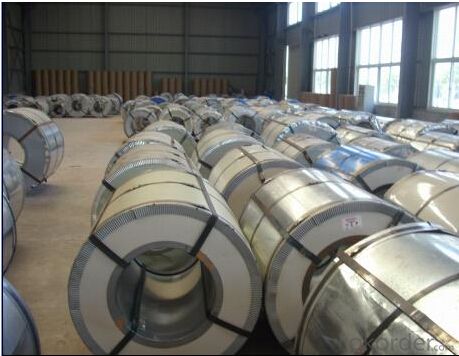


- Q: What are the typical tolerances for steel coils?
- The typical tolerances for steel coils vary depending on the specific requirements and standards set by the industry. However, common tolerances for steel coils include thickness tolerances of +/- 0.001 to 0.005 inches, width tolerances of +/- 0.005 to 0.050 inches, and length tolerances of +/- 0.250 to 0.500 inches. These tolerances ensure that the steel coils meet the desired specifications and can be used effectively in various applications.
- Q: Molten steel changes to solid steel at its __________ point. Could you please fill in the blank? Thank you so much, it is greatly appreciated. I have been looking for the answer to this question for a long time, but I never understand what the websites are trying to say because I don't have that big of a vocabulary and don't know what they mean. I've seen things saying steel boiling point, steel melting point, and steel freezing point. I don't know what any of those mean, and they might be the answer. Please help me. Thank you.
- Carbon 'tempers' steel, by making it harder and less prone to bending (ductility). It fits the carbon atoms into the spaces in between the crystal lattice structure of the iron atoms. Too much carbon means the steel becomes more brittle, harder to weld and thus more likely to shatter under stresses which are perpendicular (shear forces) to the crystal structure of the molecules. It also is very difficult to work, requiring very high temperatures.
- Q: How are steel coils used in the production of metal furniture?
- Steel coils are used in the production of metal furniture as the primary raw material for shaping and forming various components such as frames, legs, and supports. These coils are unrolled and cut into appropriate lengths, then undergo processes like bending, welding, and shaping to create the desired furniture pieces. The strength, durability, and malleability of steel make it an ideal material for constructing sturdy and long-lasting metal furniture.
- Q: What are the challenges in coil blanking for high-strength steel?
- Coil blanking for high-strength steel poses several challenges due to the unique properties of this material. One of the main challenges is the high tensile strength of the steel, which makes it more difficult to cut and blank compared to conventional steel grades. The high-strength steel is typically harder and less malleable, leading to increased tool wear and higher cutting forces. This requires the use of specialized cutting tools that are capable of withstanding these extreme conditions. Additionally, the increased cutting forces can lead to more vibration, which may affect the accuracy and quality of the blanks. Another challenge is the spring-back effect that high-strength steel exhibits after cutting. This means that the material tends to revert to its original shape, making it difficult to achieve precise dimensions and tolerances in the blanks. This issue requires careful consideration and adjustment of the cutting parameters to minimize the spring-back effect. Moreover, high-strength steel often has a higher carbon content, which can result in increased work hardening during the blanking process. Work hardening causes the material to become even harder and more brittle, making it more prone to cracks and fractures. To overcome this challenge, proper lubrication and cooling techniques are crucial to reduce heat buildup and minimize the risk of cracking. Furthermore, the increased strength of the steel may also affect the overall production efficiency. The higher cutting forces and tool wear mean that the cutting speeds may need to be reduced, leading to longer processing times. This can impact the productivity and throughput of the coil blanking process, requiring careful optimization and planning. In summary, the challenges in coil blanking for high-strength steel include increased cutting forces, tool wear, spring-back effect, work hardening, and reduced production efficiency. Overcoming these challenges requires specialized cutting tools, precise cutting parameters, proper lubrication and cooling techniques, and careful optimization of the production process.
- Q: What is the process of uncoiling steel coils?
- The process of uncoiling steel coils involves unwinding the tightly wound steel coils using specialized equipment such as uncoiling machines or decoilers. These machines utilize hydraulic or mechanical systems to hold the coil securely while gradually releasing the tension on the coil. As the coil is released, it starts to unwind, with the steel strip gradually straightening out. This process allows for the easy feeding of the steel strip into further production processes such as cutting, stamping, or forming.
- Q: Is it faster to smith steel or mithril in Rinescape assuming I'm going to mine everything myself?Mining level: 76Smithing level: 55
- i think steel would be better since there isn't a lot of mithril ore and it would take a lot of time to mine it and it will take also 4 coals to make a mith bar and 2 only for a steel bar
- Q: What are the different types of steel coil coating materials?
- There are several different types of steel coil coating materials that are used in various industries and applications. Some of the most common types include: 1. Polyester: Polyester coil coating materials are known for their durability and resistance to weathering. They are often used in outdoor applications such as roofing and cladding, where they provide excellent protection against fading, chalking, and corrosion. 2. Polyvinylidene Fluoride (PVDF): PVDF coil coating materials are highly resistant to chemicals, UV radiation, and weathering. They are commonly used in architectural applications, where they provide long-lasting color retention and excellent protection against harsh environmental conditions. 3. Polyurethane: Polyurethane coil coating materials offer a high level of flexibility and adhesion, making them ideal for applications that require resistance to abrasion, impact, and bending. They are commonly used in the automotive and appliance industries. 4. Epoxy: Epoxy coil coating materials are known for their excellent adhesion and corrosion resistance. They are often used in industrial applications such as metal furniture, storage tanks, and machinery, where they provide long-lasting protection against chemicals and abrasion. 5. Silicone Modified Polyester (SMP): SMP coil coating materials combine the durability of polyester with the flexibility of silicone. They are commonly used in agricultural and industrial applications, where they provide excellent resistance to chipping, cracking, and peeling. These are just a few examples of the different types of steel coil coating materials available in the market. The choice of coating material depends on the specific requirements of the application, such as durability, weather resistance, chemical resistance, and aesthetics.
- Q: How are steel coils inspected for quality assurance?
- Quality assurance for steel coils involves a rigorous process that includes various tests and checks to ensure their quality. Initially, a visual inspection is carried out to identify surface defects like scratches, dents, or rust, ensuring the coils are in good condition and free from obvious flaws. Afterward, a dimensional inspection is performed to verify the coils' dimensions and tolerances. This involves measuring their width, thickness, and length to ensure they meet the specified requirements. Any deviations from the standard dimensions are noted and addressed. Moreover, mechanical testing is conducted to assess the strength and durability of the steel coils. Tensile tests are performed to measure their strength and elasticity, while impact tests evaluate their ability to withstand sudden loads or shocks. Furthermore, chemical analysis is undertaken to determine the composition and purity of the steel. Samples are taken from the coils and analyzed in a laboratory to check for impurities or elements that could affect the quality. To comply with industry standards, non-destructive testing methods like ultrasonic testing or magnetic particle inspection may be used. These methods can detect internal defects or irregularities that may not be visible to the naked eye. Additionally, surface treatment inspections, such as galvanization or coating checks, may be performed to ensure the protective layers are applied correctly and meet the necessary specifications. In summary, the quality assurance process for steel coils includes visual, dimensional, mechanical, chemical, and non-destructive testing methods. These thorough inspections guarantee that the steel coils meet the required quality standards and are suitable for their intended applications.
- Q: What are the different methods of coil recoiling for narrow strip widths?
- There exists a variety of techniques for coil recoiling targeted at narrow strip widths. One technique, known as slitting and recoiling, entails slicing the wide coil into narrower strips and then rewinding them onto a smaller coil. This is typically accomplished using a slitting machine, which can make precise cuts to achieve the desired strip widths. Another approach, referred to as edge trimming and recoiling, involves trimming the edges of the wide coil to generate narrower strips. The remaining material is then rewound onto a smaller coil. This method is commonly employed when the coil edges are damaged or uneven and need to be removed before recoiling. Furthermore, there is a method called tension recoiling. In this process, the wide coil is threaded through a series of tensioning devices that aid in achieving the desired strip widths. The tensioning devices can apply controlled pressure to the coil edges, enabling precise recoiling of narrow strips. Additionally, some companies opt to employ laser cutting technology for coil recoiling. This technique entails using a laser beam to slice the wide coil into narrow strips, which are then rewound onto a smaller coil. Laser cutting offers exceptional precision and accuracy, making it an ideal choice for narrow strip widths. In summary, the various methods of coil recoiling for narrow strip widths consist of slitting and recoiling, edge trimming and recoiling, tension recoiling, and laser cutting. Each approach possesses its own merits and is selected based on the specific requirements and capabilities of the manufacturing process.
- Q: What are the different types of steel coil surface finish treatments?
- There are numerous options for treating the surface finish of steel coils, each serving a distinct purpose and offering unique qualities. Several common types include: 1. Hot Rolling: This is a fundamental and widely-used treatment method for steel coil surface finish. It involves heating the steel above its recrystallization temperature and then rolling it to achieve the desired thickness. This process yields a rough surface texture. 2. Cold Rolling: In contrast to hot rolling, cold rolling involves rolling the steel coil at room temperature. This treatment produces a smoother surface finish with improved dimensional accuracy and tighter tolerances. 3. Galvanization: Galvanization is a process in which a protective zinc coating is applied to the surface of the steel coil. This treatment not only enhances the appearance, but also provides excellent corrosion resistance, making it suitable for outdoor applications. 4. Electro-Galvanization: Similar to galvanized steel, electro-galvanized steel coil is coated with a layer of zinc. However, this coating is applied through an electroplating process, resulting in a thinner and more controlled coating. 5. Pre-Painting: Pre-painting involves applying a layer of paint or protective coating to the steel coil before it is delivered to the customer. This treatment enhances the appearance and provides additional protection against corrosion. 6. Stainless Steel: The surface finish treatment for stainless steel coils involves passivating the steel to remove any impurities or contaminants on the surface. This process improves corrosion resistance and gives the steel a clean and smooth appearance. 7. Embossing: Embossing is a treatment where a pattern or design is pressed into the surface of the steel coil. This treatment enhances the aesthetic appeal and can provide added grip or texture, depending on the specific design. 8. Brushing: Brushing is a treatment that involves using a fine abrasive material to create a brushed pattern on the surface of the steel coil. This finish provides a unique texture and can help conceal scratches or imperfections. These are just a few examples of the different surface finish treatments available for steel coils. The choice of treatment depends on the specific requirements of the application, such as appearance, corrosion resistance, or functionality. It is crucial to select the most suitable treatment to ensure the desired outcome.
Send your message to us
Good Galvanized Steel Coil from China with Best Price
- Loading Port:
- Tianjin
- Payment Terms:
- TT OR LC
- Min Order Qty:
- 50 m.t.
- Supply Capability:
- 30000 m.t./month
OKorder Service Pledge
OKorder Financial Service
Similar products
Hot products
Hot Searches
Related keywords





